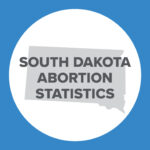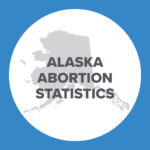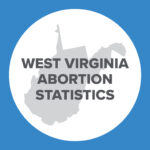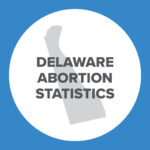Abortion Reporting: Georgia (2021)
Georgia released its 2021 abortion statistics in its online vital statistics database in July 2022. Georgia resident abortions increased from the previous year.
Statistics and Changes in Georgia Abortions, 2020-2021

The report does not include information on Planned Parenthood’s Georgia abortion market share.
Abortion Totals and Trends
In 2021, there were 34,988 abortions reported to have been performed on Georgia residents, both inside and outside Georgia. This was an increase of 12 percent from 2020 when 31,248 Georgia resident abortions were reported (Fig. 1). Georgia did not report chemical abortion statistics. The Charlotte Lozier Institute (CLI) estimates that Georgia’s 2021 abortion rate was 15.8 abortions per 1,000 women ages 15 to 44, up 11 percent from the previous year (Fig. 2). As of October 2022, 23 states had released 2021 abortion statistics, of which 16 (including Georgia) reported that abortions increased. Georgia’s abortion rate, which had trended below the national rate in previous years, now appears to have exceeded it in 2021.
Georgia’s abortion data is available in OASIS, which includes abortions performed on Georgia residents in Georgia and other states but does not include abortions performed in Georgia on nonresident women.
State Report Summary
Seven percent of Georgia resident abortions were performed on girls in their teens or younger; two percent were on girls between the ages of 10 and 17. Twenty-eight percent were on women in their early twenties, and 30 percent were on women in their later twenties. Thirty-one percent were obtained by women in their thirties and three percent were performed on women ages 40 to 55.
In 2021, 67 percent of Georgia resident abortions were performed on black women, even though black women make up only 37 percent of all Georgia resident women between the ages of 15 and 44. Just under a fifth (19 percent) of the abortions were on white women, and three percent were on Asian women. There were 83 abortions (.02 percent) on American Indian or Alaska Native women, and there were 42 abortions (.01 percent) on Native Hawaiian or other Pacific Islander women. Two percent of the abortions were obtained by multiracial women. Race was not reported for nine percent of abortions. The black resident abortion rate (28.7 abortions per 1,000 women ages 15-44) was 5.3 times higher than the white abortion rate (5.4) in 2021.
In 2021, 89 percent of Georgia resident abortions were performed on non-Hispanic women. Nine percent were on Hispanic women, and two percent were on women of unknown ethnicity.
2019 CDC Report
Georgia’s OASIS database doesn’t provide information on the pregnancy history or marital status of women undergoing abortions, and it does not include all abortions performed in the state; abortions performed on nonresidents are excluded. However, Georgia shares these statistics with the Centers for Disease Control and Prevention (CDC) to be included in the CDC’s annual abortion surveillance reports. The most recent report published by the CDC is for 2019.
According to the 2019 data Georgia shared with the CDC, 81 percent of all abortions occurring in Georgia were performed on unmarried women, 12 percent were on married women, and seven percent were on women whose marital status was not reported.
Thirty-nine percent of the abortions reported in Georgia in 2019 were obtained by women with no previous live births. Twenty-five percent were on women with one previous live birth and 37 percent were on women with two or more live births. Sixty-one percent of the abortions were performed on women with no previous abortions, while 24 percent of the abortions were on women with one prior abortion and 15 percent were on women with more than one.
Forty-four percent of the abortions occurring in Georgia were performed at six weeks of gestation or earlier. Thirty-eight percent occurred between seven and nine weeks, and 12 percent were performed between 10 and 13 weeks of gestation. Three percent were reported between 14 and 15 weeks, and two percent each were performed between 16 and 17 weeks and 18 and 20 weeks. There were 229 abortions, less than one percent of the total, performed at 21 weeks’ gestation or later. During the time periods covered by the 2019 CDC surveillance report and the 2021 statistics from Georgia’s OASIS database covered, Georgia limited abortion at 20 weeks post-fertilization, around 22 weeks of gestation.
However, after the historic overturning of Roe v. Wade in June 2022 by the Supreme Court of the United States, Georgia’s 2019 heartbeat law which had been temporarily blocked was allowed to go into effect in July 2022. The law, the LIFE Act, prohibits abortion after the heartbeat of the unborn baby is detected (usually around six weeks of gestation), except in the case where the mother’s life or a major bodily function is in danger. Abortion is also permitted up to 20 weeks’ gestation in the cases of rape and incest and if the baby has a “profound” anomaly.
State Ranking
In CLI’s 2016 paper on abortion reporting across the country, Georgia’s reporting tied for 25th best. To improve its reporting, Georgia could include in its state report all the information it provides to the CDC, including the pregnancy history and marital status of women getting abortions, the gestational ages at which abortions are performed, and the types of abortion procedures used. Georgia could also include data for all abortions performed in the state and identify the states that share abortion data with Georgia.
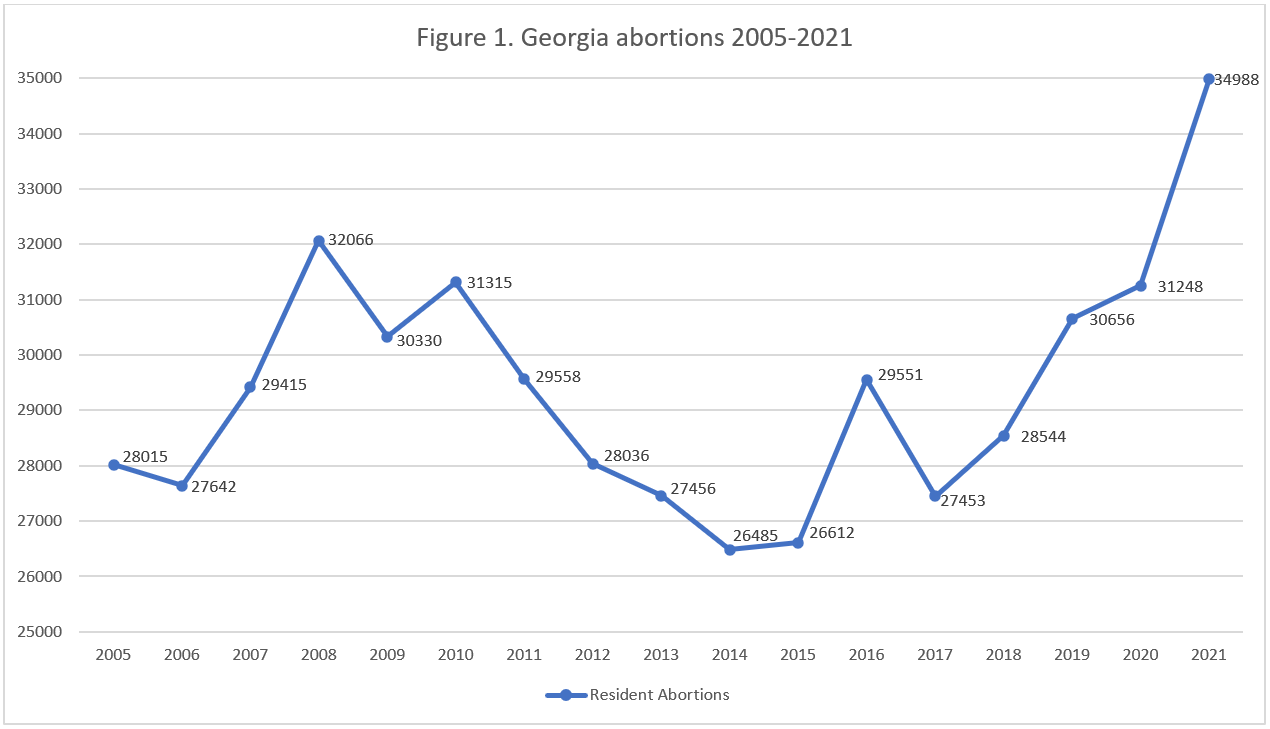
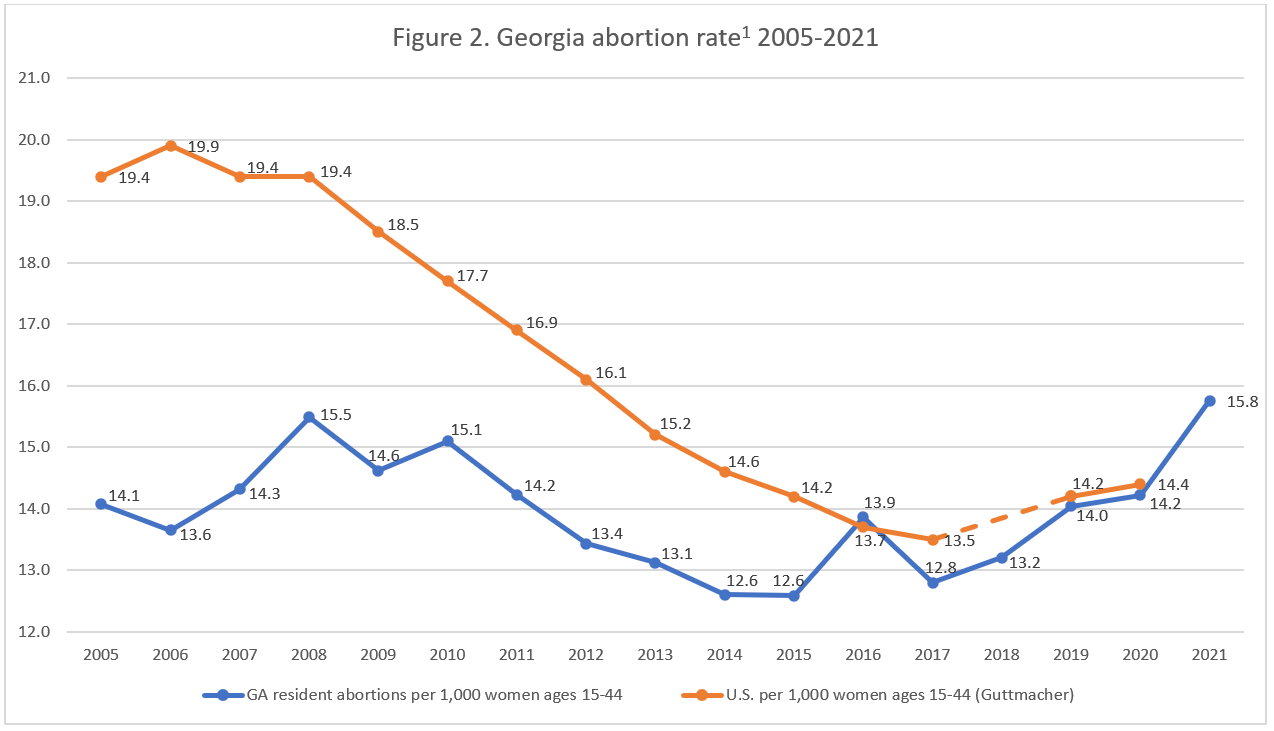
- Rates were calculated by CLI using the following formula: (abortions performed on Georgia residents ÷ number of resident women ages 15-44) x 1,000. Rates may differ slightly from previous CLI articles due to revised population estimates. Population estimates were obtained from the CDC WONDER database. Estimates for 2005-2009 are intercensal estimates of the July 1 resident population. Estimates for 2010-2019 are Vintage 2020 postcensal estimates of the July 1 resident population. Estimates for 2020-2021 are Vintage 2021 postcensal estimates of the July 1 resident population. Estimates were produced by the U.S. Census Bureau and the National Center for Health Statistics.











